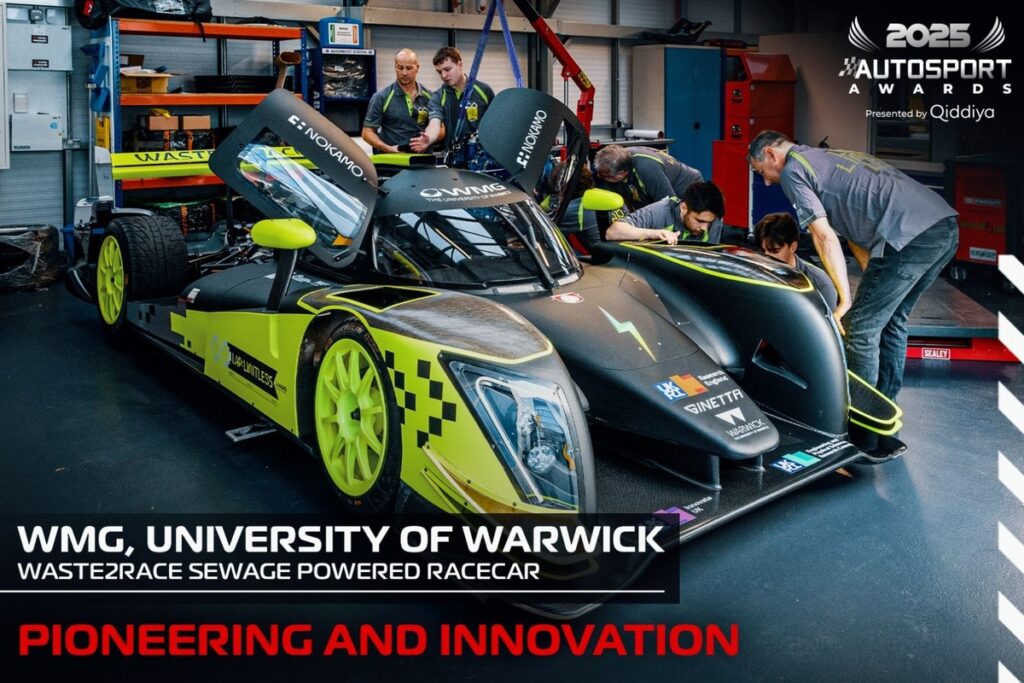Designing and building a high-performance race car using recycled materials, food waste and other unlikely scraps is nothing new to the WMG team at the University of Warwick.
Their current project is a hydrogen-powered car fuelled by sewage, the Waste2Race Le Mans Prototype (LMP3) having been built from a selection of spares, recovered parts and less obvious manufacturing materials.
The plans have been in the pipeline, as it were, as far back as 2018 when WMG was looking to celebrate a decade since building a Formula 3 car – the ‘WorldFirst’ running on chocolate and vegetable oil and built using carrots and potatoes.
Then the coronavirus pandemic halted those initial ideas, but they were only put on the backburner and now their latest iteration of a sustainable race car is catching the eye, powered from a byproduct of Wastewater Fuels treatment technology being trialled at Seven Trent.
“We had all these ideas and then we essentially spent five years developing this,” explains Professor Kerry Kirwan, chair of sustainable materials and manufacturing at WMG, and deputy pro-vice chancellor (research).
“It’s not frozen, if that makes sense. So the idea is this will be something that is used again and again and again. So new people, collaborators and new student ideas can get on board and obviously there’s environmental benefits and all these other things. So it’s really, really multifaceted.
“The sewage is the extreme end of it and the hydrogen coming off that is brilliant, but it’s actually a water treatment process that was developed, and the hydrogen is a waste product that comes off of that, believe it or not, so it’s not even green hydrogen it is better, green hydrogen.”
Waste2Race Le Mans Prototype
Photo by: WMG
It does not end there, however, as recycling has also played a major role in developing the Waste2Race concept.
“The carbon fibre, that would normally end up being in landfill, the natural fibres, then end up being composted, or animal feed or something like that. So doing something like this is so much greater for those materials and showing off what you can do with it,” added Kirwan.
“The batteries are recovered from wrecks, the whole thing is made of stuff that would have ended up going down different routes that would have been nowhere near as good as this, and that was the idea, just show potential.”
That potential sits in the design, research and development of the car, overseen by Kirwan and WMG’s chief engineer for sustainable materials, Dr James Meredith.
“We had the idea down on paper, but then it needs to be turned into something physical,” said Meredith.
“The big idea that we really wanted to work on was around the hydrogen side of things, because that was from a piece of research that we’ve done in Warwick, we had this greener-than-green hydrogen.
“What we saw with the Formula 3 car was that some of the things that we put on that car within 10 years, we are now beginning to see live in mainstream motorsport, in mainstream production cars.
“It is the same for this car, really, if we can be putting ideas on this car, which will see reality in 10 years’ time, then I think then we’ve succeeded.”
The Waste2Race car will certainly be put through its paces as WMG aims to break an, as yet undecided, record at some point in 2025 to show what it can do.
For now, a place on the shortlist for the Pioneering and Innovation Award is recognition enough, with Mark Mann-Bryans, Autosport’s business correspondent who was among the judging panel for the award, suitably impressed.
“The whole project shows such a passion for both sustainability and motorsport,” he said.
“It is the very essence of what the Pioneering and Innovation award is all about as WMG continue to push boundaries while also inspiring a generation of younger people.”
In this article
Be the first to know and subscribe for real-time news email updates on these topics
Subscribe to news alerts
Read the full article here

